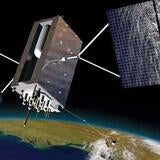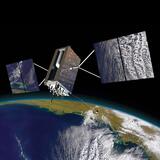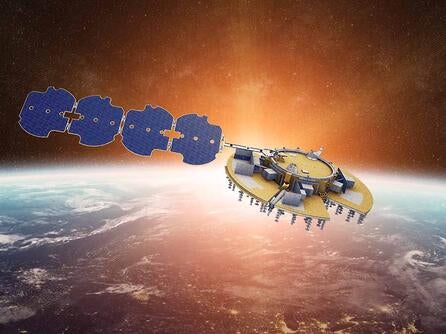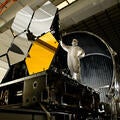L3Harris continues to help chart the course toward a new era of positioning, navigation and timing (PNT). As the prime contractor of NTS-3, the company is preparing its Navigation Technology Satellite-3 (NTS-3) for launch following successful tests earlier in 2024. Designed, built, and tested by L3Harris, NTS-3 is the first U.S. experimental, integrated navigation satellite system in nearly 50 years.
In addition to the satellite, L3Harris is also supporting launch vehicle integration, integration with the control, and user segments and on-orbit operations. The company is also delivering novel mission applications software integrated into the NTS-3 ground control system to enable responsive reprogramming of the payload. Together with Air Force Research Laboratory (AFRL)-developed reprogrammable, software-defined user equipment, the system demonstrates a multilayer, robust, and resilient geosynchronous (GEO) augmentation to GPS to ensure U.S. freedom of navigation in air, space, and terrestrial domains.
General B. Chance Saltzman, Chief of Space Operations, pointed out in the Department of the Air Force Posture Statement Fiscal Year 2025, that as threats to our national security and space environment, to include GPS, increase at alarming rates, the U.S. is accelerating the pivot towards resilient satellite constellations, ground stations, networks, and data links. To successfully navigate this rapidly evolving threat environment, the nation's warfighters need to be able to operate in GPS-degraded and GPS-denied environments. To that end, the U.S. has been conducting transformational analysis based on current and future threats, operational needs, and costs to be able to deliver resilient, effective systems and architecture.
Given these considerations, NTS-3 is smaller and lighter than traditional satellites and will operate at a different altitude. Once on-orbit, it will be used to conduct experiments that will demonstrate the resiliency that NTS-3 technology can provide to U.S. and allied military PNT. These will include, but are not limited to, flexible and advanced signals, reprogrammability, enhanced timekeeping, regional military protection, beam forming, alternative concept of operations in an end-to-end space, ground-control, and user-equipment enterprise.
Faster delivery through industry standards and modular design
L3Harris delivered NTS-3 three times faster and at lower cost than similar programs by leveraging industry standard form factors and interfaces. Its use of commercial development platforms enabled early integration and testing of software and firmware, helping to reduce risk. In addition, the satellite’s payload technology is modular and scalable and can be accommodated on different platforms.
“In today’s volatile geopolitical landscape, the need for accurate and uninterrupted PNT has never been more critical,” said Ed Zoiss, President, Space and Airborne Systems, L3Harris. “We’re looking forward to the launch and on-orbit tests of NTS-3’s cutting-edge capabilities, which are critical to updating 20th century technology for the 21st century threats that contested, degraded, and denied PNT poses to our country’s national security.”
Cutting-edge capabilities to counter threats to PNT
NTS-3’s innovative technologies include:
- Active electronically steerable phased array: NTS-3 is the first U.S. satellite to use phased array antenna technology for a space-based PNT mission, allowing simultaneous transmission of Earth-coverage beams and multiple, independently configurable regional beams. This capability enables groups with diverse needs to be supported more efficiently. Phased array technology is more power-efficient than other options and allows for graceful degradation in case of failures, significantly enhancing reliability.
- Agile waveform platform: This innovative platform features an on-board Enhanced Signal Processor and Ground Mission Application, enabling the rapid development and deployment of new signals. The Enhanced Signal Processor is fully reprogrammable on-orbit and supports legacy GPS as well as new, advanced waveforms. The Ground Mission Application enables operators to plan, configure and control Earth coverage and regional spot beams and signals to support multiple operations over a wide geographical area.
- Cion antenna/receiver: Fully reprogrammable on-orbit, the NTS-3 Cion digital space receiver can navigate autonomously if needed thanks to its ability to synch its signals to GPS. This ensures continuity if ground contact is lost.
Beyond the Satellite: Supporting the Launch
This past summer, L3Harris marked the two-year anniversary of its acquisition of power and propulsion provider, Aerojet Rocketdyne. The Vulcan rocket that will be used to launch the NTS-3 satellite is equipped with two Aerojet Rocketdyne RL10 engines, providing a combined total thrust of nearly 48,000 pounds to its Centaur V upper stage. Additionally, it utilizes 12 MR-107 thrusters and helium tanks provided by the company that are essential to the rocket’s operation. Separately, L3Harris’ Integrated Mission Systems segment is also providing key spaceflight avionics including controllers, data acquisition units, and the T-740U Transmitter, which are crucial for vehicle control and data relay during launch.
From engines and avionics to an innovative new satellite, L3Harris technology and people are helping to launch a new era of PNT. As it readies for launch, the NTS-3 satellite will help pave the way for uninterrupted, assured PNT by testing innovative technologies and techniques across space, ground control and user equipment segments.
Learn more about L3Harris’ role on the NTS-3 program.
Approved for public release; distribution is unlimited. Public Affairs release approval #AFRL20246884.






